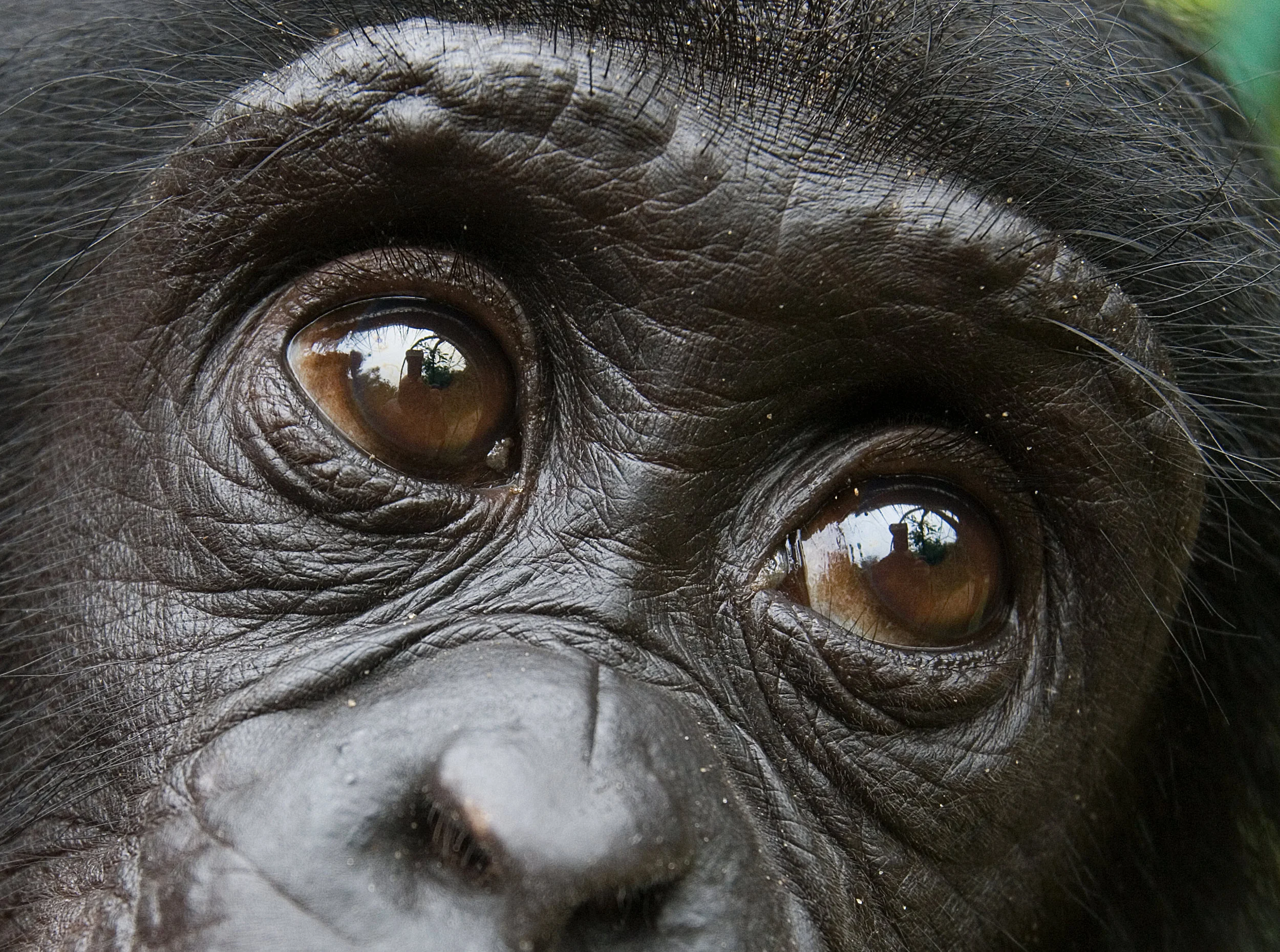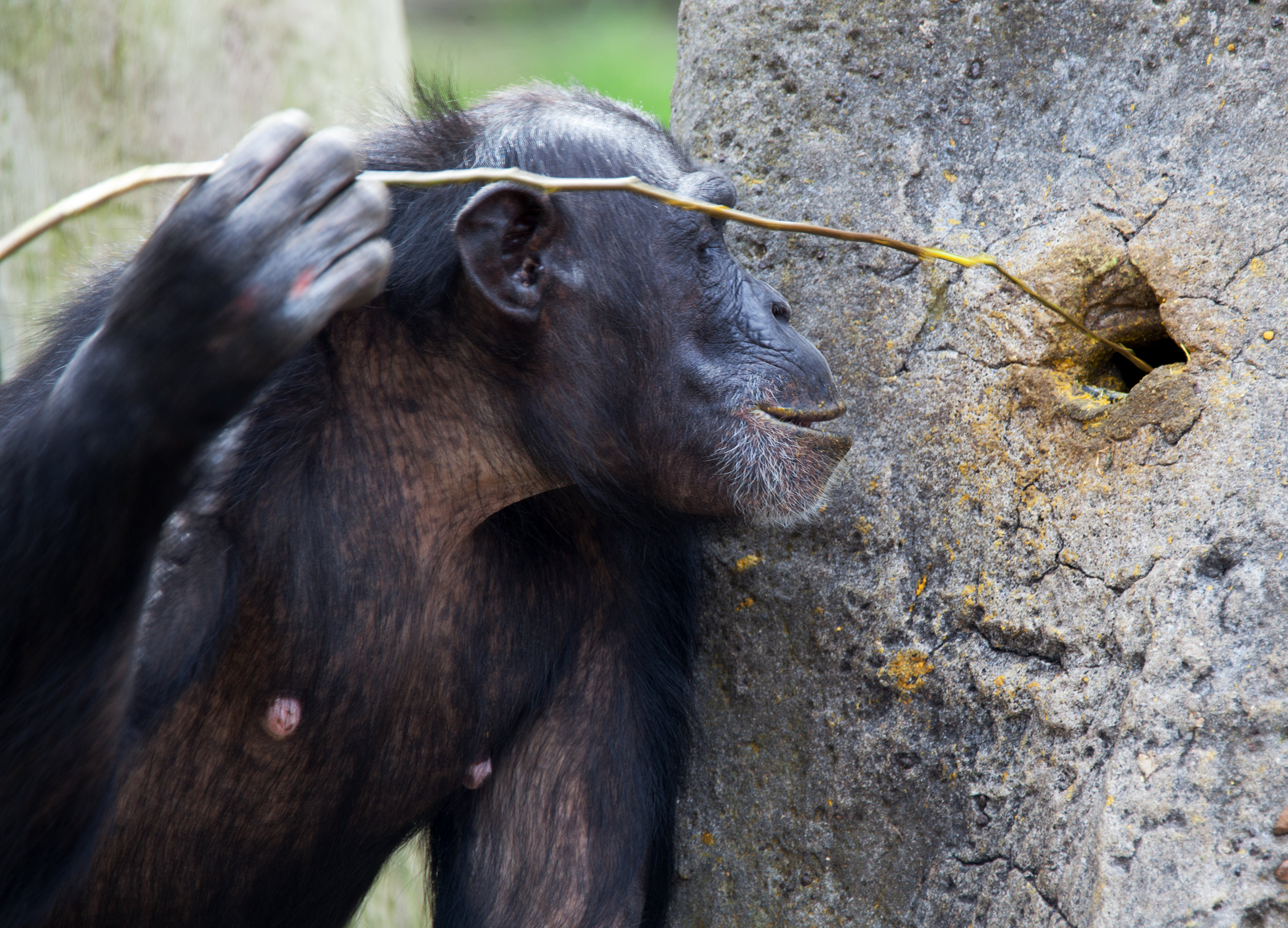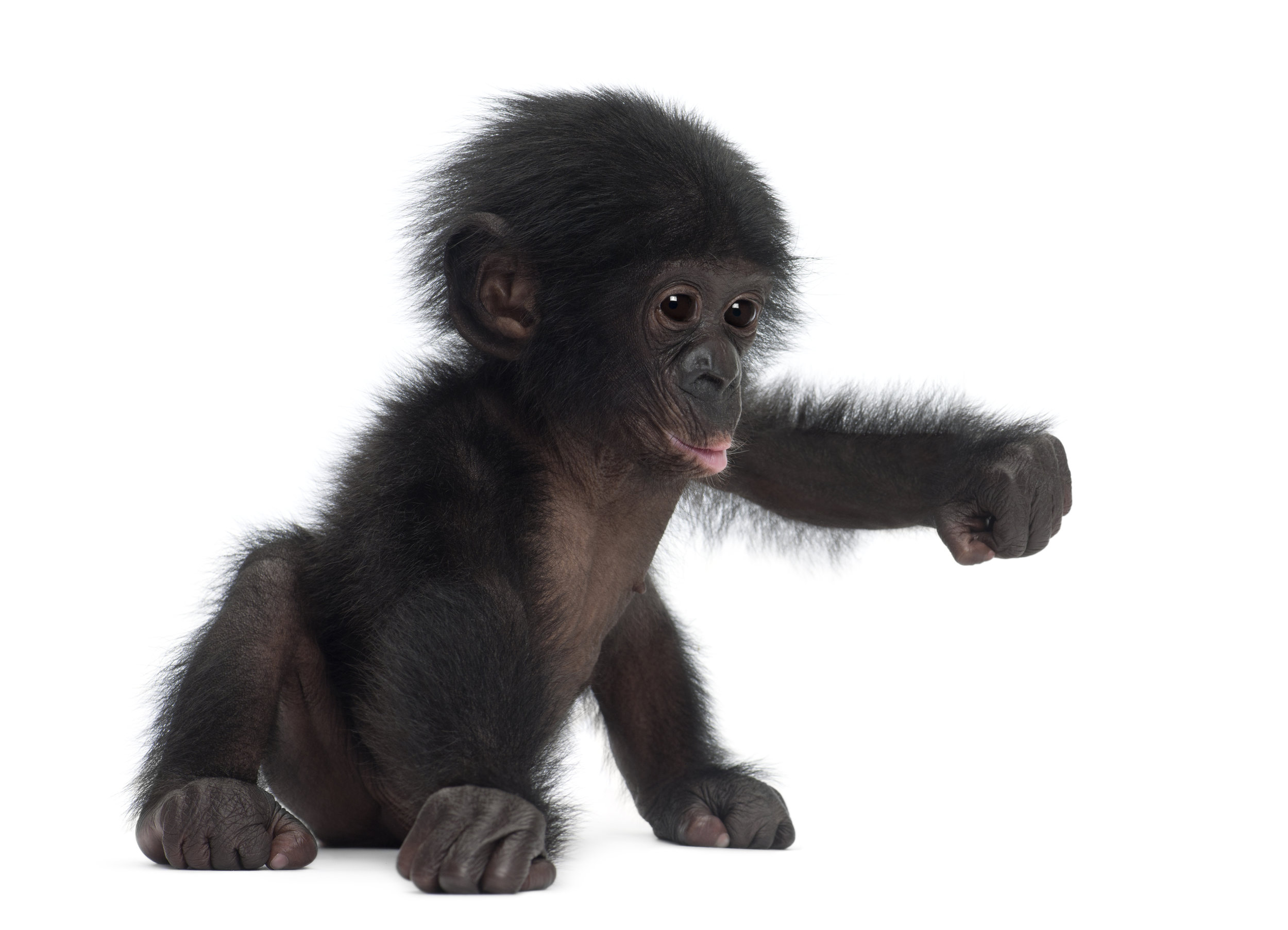A chimpanzee is a great ape.
A bonobo is also a great ape.
They are very like each other.
They leap from branch to branch in the treetops.
They can also walk on two legs.
They are like us.
What are chimpanzees and bonobos?
Chimpanzees and bonobos are great apes, closely related to each other. They are the only two members of the group of apes whose scientific name is Pan. They are just over 98% the same as humans, making them our closest relatives. They are part of the animal family Hominidae, along with gorillas, orang-utans… and humans.
Like monkeys, apes are in the group of mammals called primates.
Chimpanzees in Tanzania. Photo©Getty
Chimpanzees are found north of the Congo River, and bonobos south of the river. Neither are good swimmers. The two species are very similar and it is thought that it was the formation of the river about 2 million years ago that caused the community of a common ancestor to be split. Being poor swimmers, the group was unable to reunite and as a result they gradually developed separately and eventually became two species.
Young bonobos. Photo©Getty
Because of many years of war in the Congo, much less is known about bonobos than about chimpanzees. Many years of intensive research and observation in the wild by Jane Goodall have resulted in much greater knowledge about chimpanzees.
Chimpanzees and bonobos are thought to be the most intelligent animals on the planet after humans and are not only known to show emotion but are also great problem-solvers.
Appearance (what they look like):
Because chimpanzees and bonobos are so similar, it is hard to tell the species apart.
Both have black fur and flat faces with forward-facing eyes. Their faces are pale when they are born and darken with age. Their arms are longer than their legs, and they have long fingers. The hair on the top of a bonobo’s head has a central part and its lips are pink.
Bonobo. Photo©Getty
Chimpanzees and bonobos are similar in body size, both being about 115cm tall when standing on two legs. However, chimpanzees are bulkier and heavier than bonobos.
Bonobos are slightly smaller and more graceful than chimpanzees, and for a long time were called ‘pygmy chimpanzees’ until scientists found that they were in fact a different, though very similar, species. They have a smaller head than chimpanzees, and a flatter face and higher forehead. They have longer legs and stand more upright. Both knuckle-walk, which is walking on all fours with hands clenched to use their knuckles for support. Bonobos are able to walk on two legs more easily and for a longer time than chimpanzees.
Habitat and Distribution (Where they are found)
Chimpanzees can be found in about 20 African countries. They prefer to live in thick forest habitats in central Africa but have adapted to live in dry forests, forests near rivers, forests that flood in certain seasons, and sometimes in grasslands .
Bonobos are found in only one country, the Democratic Republic of the Congo (DRC), the second largest tropical rainforest in the world, an area of about 500,000 square kms between the Congo and Kasai Rivers.
Behaviours
Bonobos and chimpanzees are comfortable on the ground (terrestrial) and in the treetops (arboreal).
A chimpanzee moving through the treetop at speed, swinging from branch to branch. Photo©Getty
Both chimpanzees and bonobos can stand and walk upright but they spend most of their time in the treetops. They move through the trees by brachiation, which means they swing from branch to branch. They can do this very fast if they need to. They usually sleep in the trees, in nests they make out of fresh leaves.
The movements of an ape brachiating through the trees. ©Getty
Both chimpanzees and bonobos live in a social groups. The groups can be very large, but during the day a group splits into smaller groups that travel together to search for food and come together again for the night.
Bonobos are peaceful creatures. Their society is matriarchal, which means females are dominant. They are socially harmonious, able to resolve conflicts peacefully.
Chimpanzees are a male-dominated (patriarchal) social community and can exhibit some quite aggressive behaviours.
Chimpanzees make deep and guttural sounds, while bonobos make high pitched melodic sounds. Bonobos have a great range of sounds, and are the most vocal of all the apes. Communication is very important in their society and their vocal communications are often accompanied by gestures. Communications include sharing information about where favourite foods have been located, with details about quality and quantity.
Use of tools
Both chimpanzees and bonobos are known not only to use tools, but to make them to suit their purposes to help them survive in their habitat.
They shape sticks to use to get insects and grubs out of holes and logs, and use stones to smash nuts. They use leaves as sponges to soak up drinking water.
Both bonobos and chimpanzees use and make tools, in this case a stick is being used reach grubs inside a hole in a tree. Photo©Getty
Diet
Bonobos and chimpanzees are omnivores (eating meat and plants), although they are mostly vegetarian.
They eat a wide variety of fruits, and also flowers, leaves, bark, stems, roots, nuts and They eat insects and grubs, honey, eggs and worms. Occasionally they hunt and eat small mammals.
Life Cycle
When females are mature enough to breed they move to another group. A bonobo female doing this will approach an older female with an important position in the new group and attempts to make friends by grooming.
A female chimpanzee with her young. Photo©Getty
In the wild chimpanzee and bonobo females give birth at any time of year about 240 days after mating with a male. They usually have a single baby. Infants cling to their mother’s fur, and later on will ride on her back until the age of two. A female feeds and cares for her young for about 6 years, after which she is ready to breed again.
In the wild bonobos can live to the age of about 40 and chimpanzees to the age of 50.
Conservation status and threats
Both chimpanzees and bonobos are classified as Endangered.
A nine month old bonobo baby. Photo©Getty
Both species are hunted and eaten by humans. in Africa this is known as ‘bushmeat’ and is one of the greatest threats to all the apes.
War in the Congo has broken up the bonobo population so they exist in small patches of remaining habitat, which limits their ability to breed diversely: meaning they can’t change groups in order to breed and have to stay within the same group.
Logging and agriculture has further reduced chimpanzee and bonobo habitats.
Nature reserves that are protected areas have been set up in all regions.
It’s a good idea to find your information from more than one source!
Read about bonobos and watch a video:
https://www.activewild.com/bonobo-information-facts/
Read about chimpanzees:
https://www.discoverwildlife.com/animal-facts/mammals/facts-about-chimpanzees/










